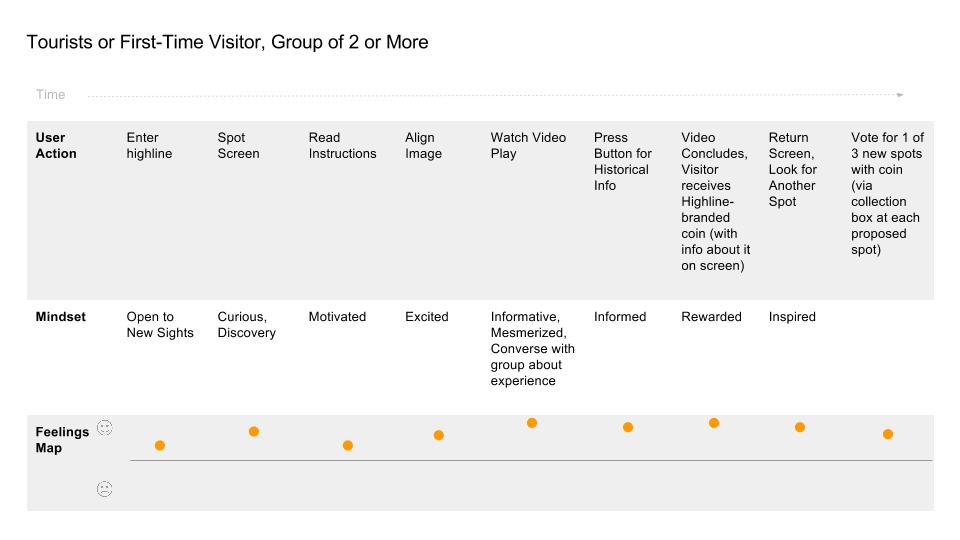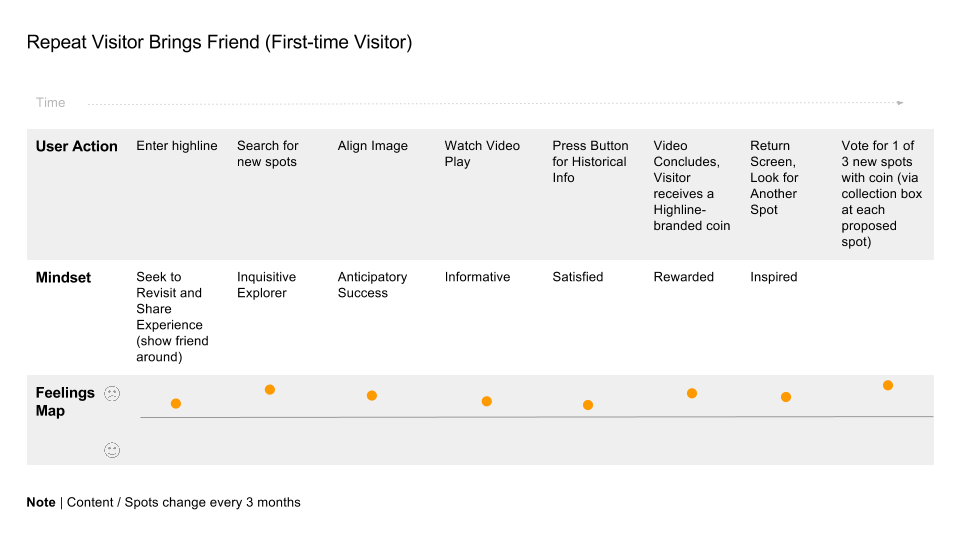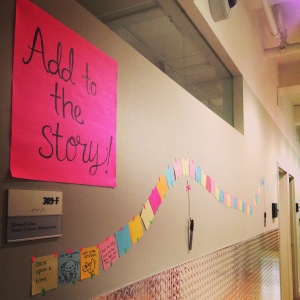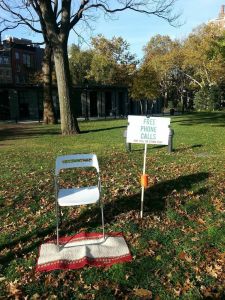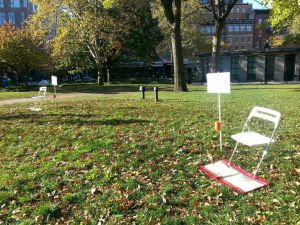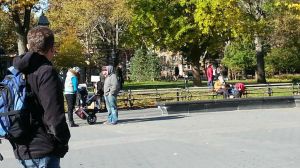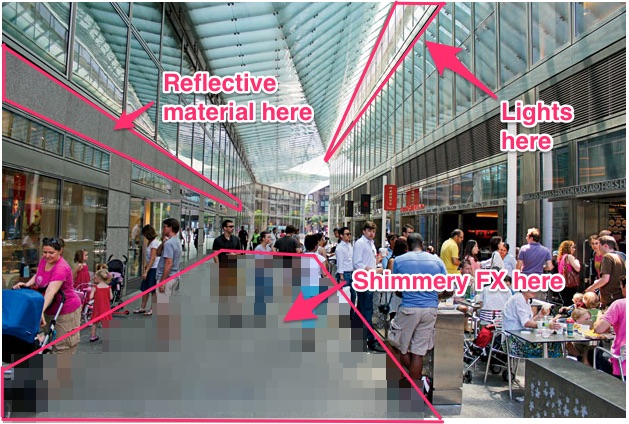Category Archives: Final project – week 3
Week 10 News
Class recap
Pete Vigeant gave a fun lecture about game design and each group participated in an exercise involving creating a game concept for the public space in which they’re working.
Assignment
Please create user experience diagrams for the next iteration of the prototype you’re planning to do. The diagrams should take two different users and walk through the experience. They should indicate the passage of time and any other characteristics of the environment that change and affect the experience. If there are multiple users involved, it should indicate their interaction. Please post your diagrams no later than Sunday, and add them to the Final project – week 4 category.
In addition, Aastha, Matt & Sarah will be presenting their tech presentations on Monday.
Filed under Final project – week 3, News
Team MALM Week 3
Original goals:
- Make people feel like kids again
- Bring people together
Goals for testing:
- Encourage people to be creative.
- Make people feel like they’re part of something bigger.
Questions:
- Will collaborative storytelling facilitate interactions?
- Will people be imaginative and unafraid to introduce wacky stories?
- Do strangers strike up conversations based on this intervention?
Analysis:
First we decided to experiment with another way to get at our goal: collaborative storytelling through a public interface. This was delightful, but didn’t gain traction as quickly as we would have liked. We ultimately decided to focus on another iteration of the tin cans for our field experiment this week.
Analysis:
The time, weather and location of the park installation matters. We had set ours up early on a cold Saturday morning, so while there was some foot traffic, there wasn’t a big crowd.
The setup of our tin cans succeeded in capturing the attention of people passing by, who stopped to read the sign or take pictures. While several people were entertained and took photos of the setup, a handful of about 6-7 people actually tried to engage with it in the cold morning weather.
At the time we were there, most of the park goers were either alone or with their dog. This made it difficult for them to try out the cans, which requires interaction between two people.
However, those who saw others interacting with the installation and were curious enough, would walk over and ask to join in. Again, there was some disbelief and surprise when they realized a tin can telephone could work.
Filed under Final project – week 3
Team Flux – Week 3
Reiteration of our goals:
Encourage contemplation of nature in an indoor/outdoor urban space by amplifying the presence of nature in the space. Bring more personality to the space via elements of intrigue and interaction. Transform the space to be more welcoming at night.
Our experiment this week:
The space is much quieter and darker at night. It’s actually somewhat eerie to walk through the long, quiet corridor. As such, we believe there’s an opportunity to make it more attractive and interactive. Through our experiments we also found that the shimmering light enhances the surroundings by playing with the wind and provide a source of intrigue. Since evening hours are less busy, people have more time to stop and interact with the installation.
Passers-by certainly seemed intrigued, and we’ve had no trouble with security yet!
Using the space:
We’re focusing on two options, one at each end of the passageway.
Filed under Final project – week 3
Team Tapper—Final Project—Week 3
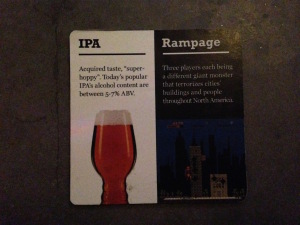
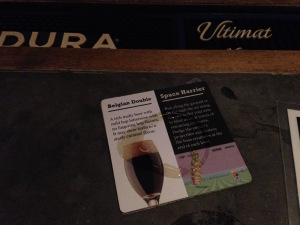
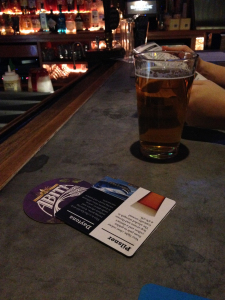
Series of Goals:
- Find out what draws people to play games
- Connect the two worlds of game playing and beer drinking
- Learn where the games are—wayfinding—awareness of what games are at each location
- Make the bar more interactive
Take away from the test 2:
- Bartender gives the coaster first before they serve the beer, so it is hard to match the beer and game through bartender
- Content on our coaster is too long to read
- Suggestion from the bartender: make it short and interesting to attract people
- Suggestion from the bartender: the layout matters, we should try other locations as well, such as St.Marks and Williamsburg
- Bartender says people play games because there is a connection to their childhood
- The location and the layout matter, for example, NYU students go to the one in St. Marks often as a group, they enjoy playing game as a group, and some barcade locations are adding more group playing games, fighting games
- Highlight that ALL of the games are 25 cents
- Coaster need to have a nice design and brighter color to be noticed
New ideas:
- Die-cut a quarter holder in all the coasters, so when someone orders a beer they have an incentive to test out an arcade game. We would have instructions on the coaster for a particular game and where it is located in the bar.
- Breeding competition with groups of friends
Filed under Final project – week 3
Team Jared–What does IxD look like to you?
We had some scheduling problems, so our group didn’t get a chance to get out to test our concept in the subway system. That said, we spent some time analyzing content and developing a schema for culling images from social media that represent the neighborhoods of these stations. We also researched and agreed on the logistics of displaying imagery we don’t have ownership over.
Filed under Final project – week 3
TEAM NDHS (Parktalk) Week 3
Original Goals:
- To create an experience that makes park-goers feel amusement and delight.
- To create a mixing of regulars, tourists, and those who are wandering through the park, with possibly a focus on those who are just crossing through
- To invite park visitors/people passing by to feel a sense of belonging
Additional Goals:
- To encourage people to express themselves freely
- To engage park visitors to feel ownership for their favorite spot
- To CrowdSource map of the park (similar to an analog Foursquare)
Original Parameters:
- We will not cause annoyances to park goers
- We will not obstruct anyone’s general path
- In labeling and identification, we will not stereotype any region of the park
- We will not create noise that overpowers the general ambiance of the park’s various pockets
- Take a photo or plan of the location that you are working in and highlight the spaces that you are activating.
2nd Prototype Installation at SVA IxD floor:
Prompt, Floor plan, and Activity icons (Killing time, Restroom, Socializing, Reading, Solo work, Napping, Class, Eating, On a call)
- First set up your second iteration at SVA IXD floor let it run for at least 24 hours, ideally 48.
We Installed on Monday, November 3rd, 2014 till Sunday, November 9th. (6 days)
2. Set it up at the actual location and document
A 64 x 48 in foamcore setup of the Washington Square Park Map (Map is draw on a separate sheet) We’ll have thumbtacks and markers (some with iconography, some blank) to accomodate various levels of engagement and participation. We will keep it unattended, with a prompt that allows the user to read and participate on their own volition. We will keep the map at 3 different locations for 15-20 minutes each.
3.Write an analysis of your findings
- 21 location markers
- 6 Solo work
- 4 Socializing (3 at SVA IXD, 1 at outside of IXD)
- 3 Killing time
- 3 Eating
- 2 Reading
- 1 Group work
- 1 Sleeping
- 1 On a call
- Women were more participatory than men
- There might be a need for a reward for more active participation – or a sense of achievement. We will explore this further when we convert our analog prototype into a digital vision.
- We may need a better way to encourage people to express themselves in a creative way. The previous iteration, when people drew directly on the paper in a “freestyle” mode, they were more graphically expressive, drawing caricatures of themselves, etc. In our current prototype, because we created iconography of various activities, people were more likely to write their name rather than draw anything in the “represent yourself” box. It also resembled a name tag (as a rectangle form).
- We have to consider what happens when a popular area gets overlapped – How will everyone be visible when we have a higher density (high traffic)? Clusters? Number counts? Data viz?
- Frequency and change over time (in a day, in a week, in an hour, in a certain season?)
- We will also incorporate this map into a wayfinding digital vision (where live data and sensors could possibly impact and change a park-goer’s direction by suggestions)
- We yet don’t know how color plays a role.
Filed under Final project – week 3

